Guitar Chords You Need to Know
What are jazz guitar chords? How are jazz guitar chords built? What makes a chord minor or major? In this lesson, y'all will learn how to construct jazz guitar chords. Learning the (relative) simple theory behind chords will make your life as a jazz guitar player a lot easier and is essential when learning how to play guitar chords, so let's dive straight in!
Major Chord Construction
To get started, we begin with a scale we all know, the C major scale. The 7 notes in this calibration are numbered, these numbers are of import (they are like a formula).
| C Major Scale | C | D | E | F | One thousand | A | B |
|---|---|---|---|---|---|---|---|
| 1 | two | 3 | 4 | 5 | half-dozen | 7 |
Chords are based on third intervals. There are 2 kinds of thirds (or 3rds):
| Pocket-size Tertiary | Interval of 3 one-half steps | Symbol: minor 3rd |
|---|---|---|
| Major Third | Interval of 4 half steps | Symbol: major 3rd |
Permit's start past stacking 2 thirds on the showtime notation (one, also called the root) of the C major calibration:
The result is a C major triad or C (a triad is a chord that contains iii notes).
- From note C to Eastward is a major 3rd (four half steps)
- From annotation E to G a small 3rd (three half steps)
Every major chord has this construction: first a major third, then a pocket-size third. A chord like this is chosen major considering there is a major 3rd (4 one-half steps) betwixt the root and the 3rd.
Memorize the chord formula for major chords: i three 5
Minor Chord Construction
Now let's stack 2 thirds on top of the second note (2) of the C major scale. This might be a scrap disruptive, only nosotros now call that 2d note of the major scale "one", because it becomes the root of our chord:
The result is a D small-scale triad or Dm.
- From D to F is a minor third
- From F to A is a major third
Every modest chord has this structure: first a minor tertiary, so a major third (the mirror of a major chord). A chord like this is chosen minor because there is a small third (3 half steps) between the root and the 3rd.
Memorize the chord formula for pocket-sized chords: 1 b3 five
Important : the b (aka flat) before the 3 means a one-half tone lower (than iii). Further in this tutorial nosotros'll encounter a # (aka sharp), which means a half tone higher. A half tone on the guitar is 1 fret.
Dim Chord Construction
Dorsum to the C major calibration. Now we're going to skip a few notes and stack thirds on the 7th note (7) of the C major scale:
The issue is a B diminished triad or Bdim.
- From B to D is a minor 3rd
- From D to F is also a modest 3rd
Every macerated triad chord has this construction: a minor tertiary and another minor 3rd.
Memorize the chord formula for diminished chords: 1 b3 b5
Diatonic Chords
I'll summarize and consummate the other notes of the C major scale:
| Notes | Formula | Chord Name | Symbol | |
| ane | C E Chiliad | 1 3 v | C major | C |
| two | D F A | i b3 5 | D minor | Dm or Dmin or D- |
| 3 | Eastward G B | ane b3 5 | Eastward small | Em or Emin or Eastward- |
| 4 | F A C | 1 3 5 | F major | F |
| v | G B D | 1 three 5 | G major | G |
| vi | A C Due east | 1 b3 5 | A pocket-size | Am or Amin or A- |
| seven | B D F | 1 b3 b5 | B macerated | Bdim or B° |
These chords are called the diatonic chords of C major.
Finding Chord Tones
Next you'll learn how to find the notes of a chord in a convenient way. There are actually 2 methods to construct chords. The offset method is explained here, the 2d (more applied) method, y'all'll larn a bit further in this lesson:
The first method starts from the major scale and involves 3 steps:
one) Find the major scale of a given cardinal.
Case: to find the notes of a Gm chord, outset detect the notes of the G major scale:
| G Major Scale | G | A | B | C | D | E | F# |
|---|---|---|---|---|---|---|---|
| 1 | 2 | 3 | four | five | half dozen | vii |
two) Construct the major chord by using the major chord formula: ane three 5
Example: In our G major example that would exist:
3) Apply the pocket-size chord formula to the major chord. The chord formula for small chords is 1 b3 5.
Example: This ways the 3rd of the major chord (Grand B D) has to be lowered half a step. This is because in a minor chord (ane b3 five) there is a b in forepart of the 3, meaning the 3 is a half tone lower than the iii in the major chord (one iii 5), where there is no b before the 3.
Making the iii (B) a one-half note lower is washed past placing a b behind the annotation, like this: Bb (aka B flat). This is a chip disruptive because in formulas nosotros place the b before the annotation, merely with actual chord tones, we place the b after the annotation.
The other notes of the chord don't alter, so these are the notes of a G minor chord:
To visualize this, accept a expect at the notes on the guitar neck:
At the left are the 3 notes of One thousand (1 iii 5 = G B D).
At the right are the 3 notes of Gm (1 b3 v = K Bb D). The Bb is one fret (= half tone) lower than B:
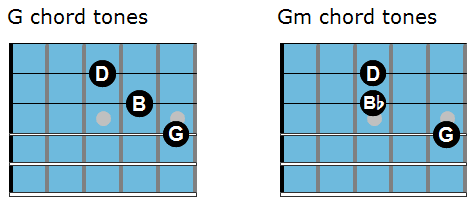
Maj7 Chord Construction
Let's have a look at seventh chords.
Seventh chords are chords that incorporate 4 or more than different notes and are the staff of life and butter of jazz music.
Again, let's start with the C major scale:
| C Major Calibration | C | D | East | F | G | A | B |
|---|---|---|---|---|---|---|---|
| 1 | 2 | iii | iv | 5 | 6 | 7 |
The structure of seventh chords follows the same principle as amalgam triads: stacking thirds on top of each other. Triads were made by stacking two thirds on peak of the root. Seventh chords are constructed by stacking 3 thirds on top of the root.
Let'due south stack three thirds on the ane of the C major scale:
The result is a C major 7 chord (Cmaj7).
- From C to E is a major tertiary.
- From E to G is a small-scale third.
- From Grand to B is a major tertiary.
Every major 7 chord has this structure: first a major tertiary, and then a small-scale third, followed by a major third.
Memorize the chord formula for major 7 chords: 1 3 5 seven
m7 Chord Construction
Let's practise the aforementioned for the 2nd note of the C major scale:
The effect is a D minor 7 chord or Dm7.
- From D to F is a minor third.
- From F to A is a major third.
- From A to C is a minor third.
Every minor 7 chord has this structure: offset a minor 3rd, and then a major third, then a small third.
Memorize the chord formula for minor vii chords: 1 b3 5 b7
Dominant 7 Chord Construction
Now let'southward skip some notes and stack 3 thirds on tiptop of the 5th notation of the C major scale:
The result is a 1000 dominant 7 chord or G7.
- From G to B is a major
third. - from B to D is a small tertiary.
- From D to F is a minor third.
Every dominant 7 chord has this structure: outset a major 3rd, and then a minor third, followed by another minor 3rd.
Memorize the chord formula for ascendant 7 chords: 1 3 5 b7
Acquire more about dominant chords in this lesson: What Is a Dominant Chord?
m7b5 Chord Construction
We'll skip some more than notes and stack 3 thirds on top of the 7th note of the C major scale:
The result is a B half diminished chord or Bm7b5.
- From B to D is a pocket-sized third.
- From D to F is a minor tertiary.
- From F to A is a major third.
Every one-half diminished 7 chord has this structure: showtime a small-scale third, another small third, followed by a major 3rd.
Memorize the chord formula for half diminished 7 chords: 1 b3 b5 b7
Diatonic 7th Chords
I'll summarize and complete the other notes of the C major scale:
| Notes | Formula | Chord Name | Symbol | |
| i | C E G B | 1 iii 5 vii | C major vii | Cmaj7 |
| 2 | D F A C | 1 b3 5 b7 | D minor 7 | Dm7 or Dmin7 or D-7 |
| 3 | E G B D | 1 b3 5 b7 | E small-scale 7 | Em7 or Emin7 or Due east-7 |
| iv | F A C E | 1 three five seven | F major 7 | Fmaj7 |
| 5 | G B D F | i 3 v b7 | G dominant vii | G7 |
| 6 | A C East G | 1 b3 5 b7 | A pocket-size 7 | Am7 or Amin7 or A-7 |
| seven | B D F A | ane b3 b5 b7 | B half diminished vii | Bm7b5 or Bmin7b5 |
Now that nosotros know how seventh chords are synthetic, we'll focus our attention on tensions in the next section.
Maj9 Chord Construction
Tensions (aka extensions) are notes that are part of a chord, only are not chord tones (i 3 5 7).
The first extension nosotros'll have a look at is the 9
Hither's the C major calibration again:
| C Major Scale | C | D | E | F | One thousand | A | B |
|---|---|---|---|---|---|---|---|
| 1 | 2 | 3 | four | v | 6 | 7 |
There are iii notes left in the major scale that are not chord tones: 2, 4 and six
If we add these tones to the chord, they become tensions. Virtually of the fourth dimension we play tensions an octave college than chord tones considering otherwise they get in the way of the chord tones (the chord would sound "muddied"). That's too the manner tensions are notated:
- two becomes nine: two + 7 (the corporeality of notes in an octave) = 9
- four becomes 11
- 6 becomes thirteen
So if we add the ii to Cmaj7 we get Cmaj9:
| C | E | G | B | D |
| 1 | 3 | 5 | 7 | ix |
Special Cases – 4ths and 6ths
The 2 other notes that are left in the scale (4 and six), are special cases in combination with major chords:
- Outset of all, at that place is something we call avert notes: notes that are a half tone above a chord tone. Avoid notes sound dissonant, that's why they are by and large avoided.The 4 of the C major scale (f) is a half step higher up the eastward (the 3rd of Cmaj7). So the 4 (f) is an avert note for Cmaj7 and is non often used on this chord.
- The vi is too a special case in combination with major chords. Most of the times when we add together a 6 to a major chord, the 7 is omitted and in that location is no octave added to the 6. This is considering the 6 and 7 go in each other's way.
And then if we add the half-dozen to C major chord we become a C6:
The same goes for 6 in combination with small-scale chords: the b7 is omitted.
If we add the 6 to Dm7 we become Dm6.Note that the 6 is no longer A like in the C6 example to a higher place considering the root of the chord changed to D. The vi is now B (D Eastward F G A B C).
The 4 is not an avoid note in combination with minor chords considering information technology is two half tones in a higher place the b3 and not one one-half tone.
When you lot add the four to Dm7, yous get a Dm11 chord:
| D | F | A | C | G |
| 1 | b3 | 5 | b7 | eleven |
(Annotation: theoretically, the 9 should be included besides in a minor eleven chord)
The four is also a special case in combination with dominant chords. When a four is added to a dominant chord, the 3 is omitted. Chords like these are called sus4 chords and ofttimes function as a delay for a dominant chord.
Sus4 chords often include a 9. Hither's the G9sus4 chord:
| G | C | D | F | A |
| 1 | 4 | 5 | b7 | 9 |
There'south also something chosen altered tensions (b9, #nine, b5, b13). These tensions come from the harmonic minor scale or from the altered scale and will exist covered afterward in another lesson. The same for goes for #11, which comes from the Lydian dominant scale.
Diatonic Tensions
Here's a list of all chord types we've seen and then far and their tensions:
| Chord Type | Extension | Symbol | |
| Major | 9 (=2) | Cmaj9 | |
| iv #11 (=#4) | / Cmaj7#11 | avoid note #11 comes from the lydian scale | |
| 6 | C6 | seven is omitted | |
| Minor | 9 (=2) | Cm9 | |
| 11 (=4) | Cm11 | ||
| 6 | Cm6 | b7 is omitted | |
| Dominant | 9 (=ii) | C9 | |
| b9 (=b2) | C7b9 | b9 comes from the altered scale or the fifth mode of the harmonic minor scale | |
| #9 (=#ii) | C7#9 | #9 comes from the altered scale | |
| 4 | C7sus4 | ||
| 13 (=6) | C13 | ||
| b13 (=b6) | C7b13 | b13 comes from the altered calibration or the 5th style of the harmonic minor scale |
Chord Formulas
Here's a summary of thechord formulas we covered until now + some additional chord types.
| Chord Type | Chord Formula |
| Major Triad | 1 iii 5 |
| Minor Triad | 1 b3 5 |
| Diminished Triad | 1 b3 b5 |
| Augmented Triad | 1 3 #5 |
| Major seven | ane 3 5 7 |
| Small vii | 1 b3 5 b7 |
| Dominant 7 | one 3 5 b7 |
| Half Macerated 7 | ane b3 b5 b7 |
| Macerated seven | one b3 b5 bb7 |
| Augmented 7 | 1 iii #v b7 |
| Suspended 4 | i 4 5 b7 |
| Pocket-sized/Major 7 | i b3 v 7 |
A Practical Method For Chord Construction
Earlier in this lesson yous learned a first method to construct chords. At present y'all'll acquire a faster and more practical method.
The first footstep is memorizing the chords and chord tones of the C major scale and their chord formulas:
| Cmaj7 | C East G B | 1 3 5 7 |
| Dm7 | D F A C | 1 b3 5 b7 |
| Em7 | E K B D | 1 b3 five b7 |
| Fmaj7 | F A C East | 1 3 5 7 |
| G7 | G B D F | one 3 5 b7 |
| Am7 | A C Due east Thou | i b3 5 b7 |
| Bm7b5 | B D F A | 1 b3 b5 b7 |
You must be able to film the chord types, chord tones and formulas of C major without thinking.
The balance of this method is best explained with some examples…
Chord Building Examples
At present that you lot know the chords of C major, it's easy to find chords of other keys.
Example 1: to find the chord tones of Cm7:
- Y'all know the chord tones of Cmaj7: C E G B
- You know the chord formula of Cmaj7: i iii 5 7
- You know the chord formula of minor 7: 1 b3 5 b7
- Adapt the chord tones of Cmaj7 to the formula of small-scale seven: bring the 3 and the 7 a half step down.
- Decision: the chord tones of Cm7 are: C Eb G Bb
Case 2: the chord tones of Ddim7:
- You know the chord tones of Dm7: D F A C
- You know the formula of Dm7: 1 b3 5 b7
- Yous know the formula of macerated vii: ane b3 b5 bb7
- Adjust the chord tones of Dm7 to the formula of macerated 7: bring
the 5 and the 7 a half pace downwards - Conclusion: the chord tones of Ddim7 are: D F Ab B
Example 3: the chord tones of F#vii:
- You know the chord tones of Fmaj7: F A C E
- To discover the chord tones of F#maj7 you just take to raise each chord tone a half pace: F# A# C# East#
- You lot know the formula of major 7: one 3 5 7
- You lot know the formula of dominant 7: 1 3 5 b7
- Accommodate the chord tones of F#maj7 to the formula of dominant 7: bring the 7 a half step downwardly
- Conclusion: the chord tones of F#7 are: F# A# C# Eastward
Now you know how to find the notes of a chord, merely how do you translate this to the guitar?
Translating Chord Theory to the Guitar
The first matter you need to know is that non every chord tone is equally
important:
- 3 and seven are the important notes of a chord considering they determine the chord type. They are also important for vocalisation leading.
- The 1 is the least important note, considering it is usually played by the bass actor.
- The 5 is non and then important either and can be disturbing sometimes.
- Tensions add color and interest to a chord, then it's preferable to use tensions instead of 1 and five.
The second matter y'all need to know is that ane one-half step equals ane fret on the guitar.
Here's an instance with chord diagrams, we'll starting time with a C: C E M (1 3 5)
Let's have a look at the chord diagram:
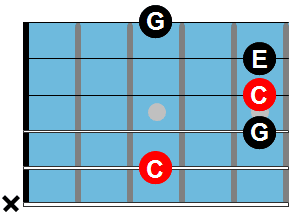
X15135: C
From lesser to tiptop (from low E string to high E string) nosotros have:
- 10: the depression Due east-cord is not played
- 1: the 1 or root of the chord is played on the A-string
- 5: the 5th of the chord is played on the D-string
- one: over again the root, but now on the G-cord
- 3: the tertiary is played on the B-cord
- 5: the 5th is played again, simply this time on the high Eastward-string
You lot see that it is OK to duplicate chord tones, like the one and the five in our case.
This chord doesn't sound very jazzy though, so permit's spice information technology up a flake and make information technology a Cmaj7 (ane 3 v 7) by replacing the i on the G-cord with the vii:
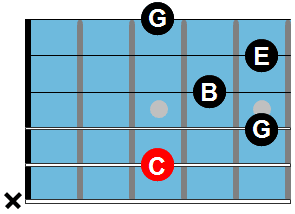
X15735: Cmaj7
Instead of duplicating the root on the G-string, we exchanged it for the 7 of the chord.
Now permit'due south add some color, allow'southward brand it a Cmaj9 chord (1 3 5 7 9):
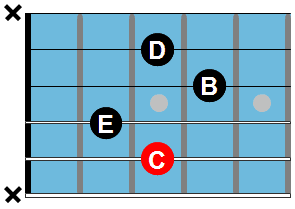
X1379X: Cmaj9
Nosotros exchanged the 5th on the D-string for the 3rd and we inverse the 3rd on the B-string to a nine.
This Cmaj9 would be a overnice chord if yous're playing Bossa Nova, solo guitar or in duo setting, but if you play with a bass role player and yous don't desire to get in his way, it's better to omit the root and to play on the higher strings only:
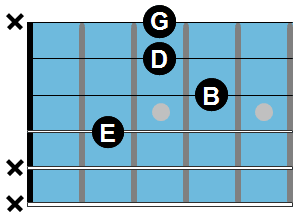
XX3795: Cmaj9/Due east
Chord Inversions
Instead of playing the root of the chord, we play the 5th on the high E-string in the previous example. A chord like this is called a chord inversion
A chord inversion is a chord that doesn't have its root as its bass note.
At that place are three types of chord inversions:
- First inversion: the tertiary in the bass.
- 2d inversion: the fifth in the bass.
- Tertiary inversion: the 7th in the bass.
In our previous case we take a Cmaj9 chord with the 3rd (E) in the bass, notated like this: Cmaj9/East
What do y'all demand to do if you desire to make this chord dominant? Unproblematic, but look at the chord formulas: the 7 has to become a half step down (major is 1 3 5 vii, ascendant is i iii five b7).
Have a wait at the chord diagram, the b on the chiliad-string has to become a b flat. The result is the first inversion of C9: C9/Eastward
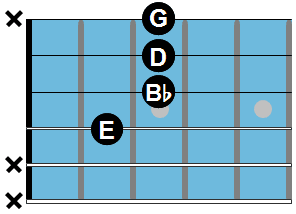
XX3b795: C9/Eastward
And if we want to make this chord modest? Starting from the dominant chord we have to lower the 3rd a half pace (dominant is 1 three v b7, small is 1 b3 5 b7). On the guitar, this means nosotros have to lower the e note on the d-string half a stride to an due east apartment. The result is the beginning inversion of Cm9: Cm9/E
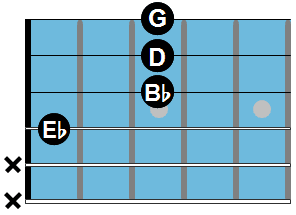
XXb3b795: Cm9/Eb
To learn how you can effectively use chords in jazz, how to use chord tones to solo (arpeggios) and how to play chords and melody at once, check our Piece of cake Guide to Jazz Guitar three eBook Bundle

phillipslegreasing.blogspot.com
Source: https://www.jazzguitar.be/blog/jazz-guitar-chord-theory/

0 Response to "Guitar Chords You Need to Know"
Post a Comment